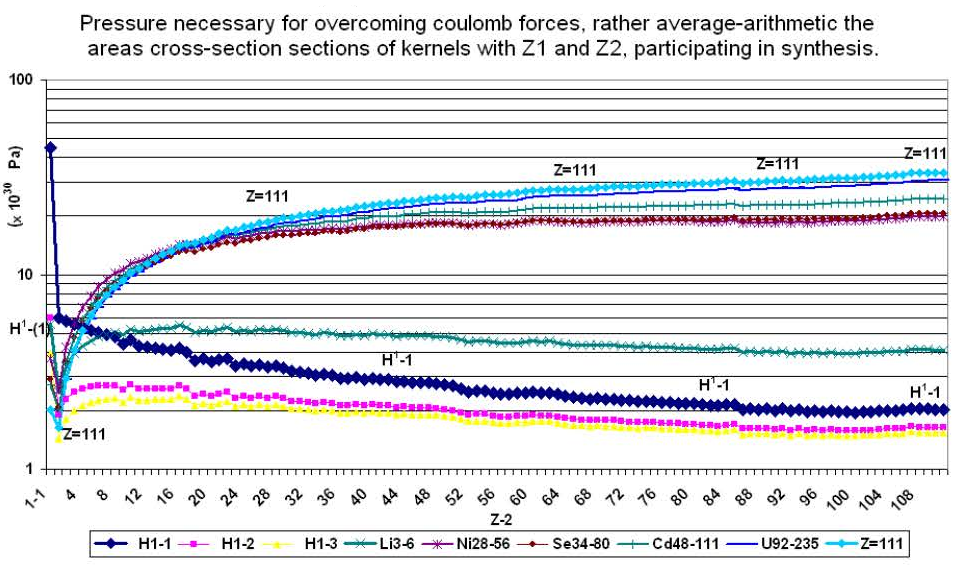(34) Schedule № G-2.18
(35) Schedule № G-2.19
The schedules № G-2.18 and № G-2.19 are constructed on the basis of the formula (2.100).From which we see the acknowledgement of the conclusions we made before.
From the cases considered by us it is possible to draw conclusions:
1. The maximal value of pressure of resistance to synthesis of nuclear kernels, at a proton.
2. The maximal value of pressure of resistance to synthesis of two nuclear kernels — at the moment of synthesis of two protons.
3. Pressure which is necessary for creating the synthesis of two moving kernels is less than necessary pressure for the synthesis of two protons.
4. The maximal pressure of resistance to the synthesis arises at synthesis of two protons. At other kernels of the periodic table, this pressure of resistance is lower.
At synthesis of the majority of kernels, up to z2=60, the value of resistance is lower than the value of resistance at the synthesis of a proton and a kernel of hydrogen with z=1 and А=2.
5. In case when both of the kernels move to a point of the synthesis, the pressure necessary for the given reaction is lower, than in case when one kernel moves.
On the basis of conclusions 1, 2, 3 and considering that the fact of synthesis of hydrogen and protons in stars is considered as established, and comparing the pressure is necessary for the synthesis of protons and kernels of hydrogen, with similar characteristics of kernels of elements of the periodic table, it is possible to draw a unequivocal conclusion, that heavy and super heavy kernels are synthesized in stars.
6. Apparently from schedules, the most economic variants of synthesis are possible at high speeds of easy kernels and low speeds of the heavy.
At the moment of synthesis of easy kernels more energy is allocated and the synthesis of heavy kernels is accompanied by allocation of a small portion of energy or its absorption. Hence, kernels of small weight, at synthesis, receive greater speed, and kernels of greater weights — smaller, that corresponds with the most economic variant of synthesis of kernels. It confirms the probability of synthesis of heavy kernels in stars.
Is the synthesis of heavy kernels in stars is possible?
The practice says – «Yes, there is a synthesis of heavy kernels occurring in stars!» The theoretical physicists of the past century didn’t consider the dynamic conditions within the stars, the kernels velocity and particles created during the synthesis and the form of the star itself, which creates favorable conditions for the synthesis of heavy kernels throughout the whole periodic table of elements.
Going forward, as the proof of the possibility of heavy kernels synthesis in stars, we’ll consider briefly the analytical data we obtained in chapter 4.The analysis of «a solar wind». In this chapter we calculated the velocity of the kernels obtained by the synthesis. The data from these calculations matches the parameters of the solar wind. Comparing the results of these calculations with the parameters of moving particles in particle accelerators, we see that the kernel obtained by the synthesis has the same speed as the kernels which were accelerated in accelerators for the production of synthesis of heavy kernels.
In the particle accelerators, the light kernels have the speed, while the target kernels are not mobile. In a star, most of the kernels involved in the synthesis have high speed, which facilitates the synthesis of heavy kernels. Let’s consider some examples.
Table № T-2.1, shows the parameters of the Coulomb barrier for the reaction of the proton-11p (11H), 21d (21H) of the deuteron and alpha-particles (42He) of heavy kernels 23290Th. For a proton (p) and deuteron (d) the Coulomb barrier equals to 15.1 MeV, for an alpha-particle (42He) — 30 MeV, provided that the target nucleus Th is not mobile. From the table №T-4.2, we see that the kernels obtained during the synthesis have high speed
21H+21H=42He+23.84 MeV v~1918.8 km /s
31H+10n=42He+20.57 MeV v~1655.78 km /s
11p+11p=21H+ +β + ν + 1442.218 keV v~230.62 km /s
21H+10n= 31H+657.426 keV v~668.2 km /s
Reaction 31H+10n=42He and 21H+10n= 31H occur without overcoming the Coulomb barrier.
The reaction of 21H+21H=42He released the 23.84 MeV, if we consider that in a star, the kernels of the target atoms have high speed, then it is safe to say that the synthesized kernels 42He will overcome the Coulomb barrier is higher than 30 MeV and will be able to participate in the synthesis of kernels with Z> 90. Heavy kernels are saturated and supersaturated with neutrons; hence, for their saturation with neutrons, synthesis reactions of heavy kernels with neutrons are necessary and possible: AZX+10n = (A+1)ZX
Consequently, the possible reaction of synthesis of heavy kernels with neutrons and subsequent release of a positron is: AZX+10n = (A+1) (Z+1)Y++e
For such synthesis reactions is not necessary to overcome the Coulomb barrier!
A Spectroscopy of the solar surface shows the presence of all elements of the periodic table, including the transuranium elements.
That means that the spectroscopy of the Sun gives us information not about the chemical composition of stars, but about the synthesis of kernels in the upper layers of the star. Consequently, in the «active zone», we see a synthesis of all elements of the periodic table, and this proves the existence of synthesis of transuranic elements in the star.



